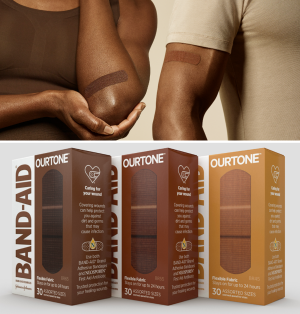Derm Faculty Advocate for Diversity in Bandage Choice



UW Medicine will begin offering patients band aids, or adhesive bandages, in a range of diverse skin tones beginning in September thanks to the continued support and advocacy of UW Dermatology faculty members.
 Dr. Jay Vary, Associate Professor for the UW Division of Dermatology and dermatologist at UW Medical Center's Roosevelt Dermatology Clinic, and Dr. Andrea Kalus, Associate Professor and co-director of the Rheumatology-Dermatology Clinic helped lead the proposal to supply clinics and hospitals across the UW Medicine system with bandages in colors that celebrate and recognize the multitude of skin tones found in patients. Until recently, many clinics only offered patients the peachy-beige “flesh” color which band aids have become synonymous with.
Dr. Jay Vary, Associate Professor for the UW Division of Dermatology and dermatologist at UW Medical Center's Roosevelt Dermatology Clinic, and Dr. Andrea Kalus, Associate Professor and co-director of the Rheumatology-Dermatology Clinic helped lead the proposal to supply clinics and hospitals across the UW Medicine system with bandages in colors that celebrate and recognize the multitude of skin tones found in patients. Until recently, many clinics only offered patients the peachy-beige “flesh” color which band aids have become synonymous with.
“For years we have had only one choice of color for bandages,” says Dr. Vary, who worked with UW Medicine’s supply chain staff and medical equipment vendors to identify band aids that were readily available in additional skin tones. “This shows our patients, faculty, residents, and staff that we want them to feel included in our clinic. It shows that we recognize that this is just one way in which white skin has been defined as normal and a default in medicine, but it is one that we can change while we continue to work on others.”
A Call for Inclusivity & Representation

This seemingly small, but significant change aligns with UW Medicine’s continuing effort to promote inclusive practices and to identify, acknowledge and dismantle policies that perpetuate structural racism and systemic bias. The massive protests that erupted across the US in the wake of George Floyd’s death in 2020, and the increased awareness around police brutality towards Black and Brown Americans, served as a catalyst for recognizing the need to address long overdue changes within UW Medicine.
“After the events of 2020 really opened a wider discussion of the importance of justice and inclusivity in society and medicine, this proposal finally met a more receptive audience and we were able to get them in our dermatology clinic.”

After decades of demand, only recently have medical suppliers begun offering band aids in a range of skin tones. The lack of options for patients of color can be linked to the persistent lack of diversity among healthcare professionals (caregivers and administrative staff).
According to the Association of American Medical Colleges, 64 percent of all US physicians identify as male, with 56 percent identifying as white. Lack of representation is just one example of the many challenges and barriers people of color, women and LGBTQ+ people still face when seeking out care.
"Racism in medicine is so much deeper than the bandage, but it speaks volumes to me and countless others," says Linda Oyesiku, MD, MPH, who is currently completing an internship at the University of Miami Leonard M. Miller School of Medicine, and will be joining the UW Dermatology residency program in July 2022. "Hopefully it opens the eyes of many who may not have recognized the ways whiteness has been a default, and how people of color are and have been othered in every possible way — from bandages to disparities in lab values, even so far as skin color being a risk factor for disease rather than the inherent and pervasive institutional disparities and racism that has occurred over centuries."
A Clear Disadvantage
Although more widely available, Dr. Kalus initially challenged the idea to supply clinics with clear adhesive bandages as an alternative to bandages in multiple skin tones.
“Reading one of our future residents’ Linda Oyesiku’s perspective piece,
“¹A plea for making brown bandages stick,” helped me understand that clear bandages are a form of color blindness and fall woefully short of recognizing and valuing the diversity in our patients,” says Dr. Kalus.
She also notes that dermatology in particular can do more to achieve an open, diverse, and inclusive environment for patients and providers alike.
“I am also conscious that as a specialty historically lacking in diversity, we need to change our practice environment intentionally to acknowledge diversity in our patients, our staff and providers."
“We need to advocate for equity in sunscreen development, testing and usability for all skin tones. We need to question race-based associations with skin conditions to uncover where we perpetuate racism in medicine. Perpetuating a single-color bandage, even if colorless, erases diversity and misses the opportunity to celebrate it!”
Color Awareness vs Color Blindness

As providers continue to learn more about health disparities among patients of color, it's important to exercise “color awareness” when assessing and treating patients, opposed to “color blindness.” For dermatologists of color like Dr. Oyesiku, the choice of bandage is just a small reminder of the ways in which dermatologists must factor in a patient's skin color for a holistic patient assessment.
"Dermatology is a unique field in that of all the fields of medicine, it is the one where a patient's skin color truly matters," says Dr. Oyesiku. "Our lungs have no color. Our kidneys have no color. And yet, we are taught to carefully consider the skin color of the carrier of these organs when measuring or treating patients in school, according to years of research, multifactorial historical and biopsychosocial components in the etiology and the disease process."
"This is not necessarily the case in dermatology, exhibited by numerous studies showing the lack of representation of skin disease in skin of color in the "standard" learning materials, leading to less precise diagnoses or treatments for patients which can translate to delays in appropriate care and worsened outcomes. This can leave patients, and providers frankly, frustrated and less trusting. Textbooks for skin of color have existed for years due to the efforts of many dermatologists and the Skin of Color Society, but we also need to see their work incorporated in the "standard" textbooks rather than a separate entity only. As a future dermatologist of color, I was really struck by that, and wanted to see and be part of that change."









